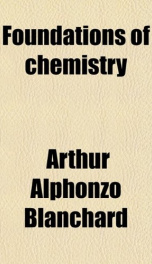foundations of chemistry

Purchase of this book includes free trial access to www.million-books.com where you can read more than a million books for free. This is an OCR edition with typos. Excerpt from book: CHAPTER III ELEMENTS AND COMPOUNDS 10. Elements. Of the substances of which we have spoken in the previous chapter, some namely, sulphur, charcoal, and iron cannot be separated into other than just the single substances by any means known to us, either by physical or by chemical processes. Such substances are known as elements; and up to the present day about eighty of these elementary substances have been discovered (see table inside the back cover). The elements may combine chemically with other elements and thereby form totally different substances, but the elements can always be separated again undiminished in weight from the compounds. For example, if one kilogram of charcoal burns, although the charcoal disappears, there is still one kilogram of carbon in the carbon dioxide which is formed. (Carbon is the name of the element of which the substance charcoal consists. The element is always carbon, whatever the form or state of chemical combination ; charcoal is a form of the uncombined element.) The carbon dioxide which escapes into the air is taken up mostly by trees and plants, where the element undergoes further chemical change, and thus this kilogram of carbon may eventually become part of the wood of trees. The wood may be charred again, and thus some at least of the original charcoal will return again to the form of charcoal. CHEMICAL COMPOUNDS 21 Whatever the final form of the one kilogram of carbon, it still exists somewhere unchanged in weight. We are perhaps not warranted in claiming with certainty that the elements are absolutely the simplest forms of matter. All that the chemist means to imply, when he calls a substance an element, is that it is something which human skill has been unable to resolve into two or more different substances.1 In the...
Info about the book
Series:
Unknown
ISBN:
1440048029
Rating:
4.5/5 (5)Your rating:
0/5
Languge:
English
Users who have this book
Users who want this book
What readers are saying
What do you think? Write your own comment on this book!
write a commentif you like foundations of chemistry try:
Do you want to exchange books? It’s EASY!
Get registered and find other users who want to give their favourite books to good hands!



